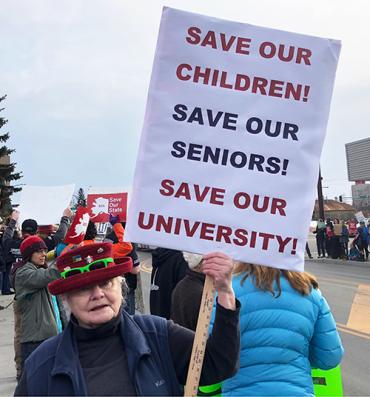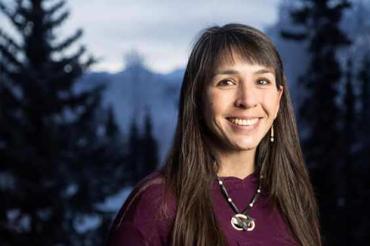Faculty, staff and students at the University of Alaska are bracing for thousands of layoffs, and possible campus closures and program eliminations, as the governor forces an unnecessary 41 percent cut in funding that will change the landscape of higher education in the state.
While there is some hope that legislators will save some of the money slashed from the university—the state's budget still is not settled, and there are daily updates on this crisis—the school is preparing for the worst. Moody’s Investors Service has already downgraded UA’s credit rating, and the Northwest Commission on Colleges and Universities, its accreditor, has warned it could lose accreditation if the cuts move forward. The university board of regents voted to declare financial exigency July 22, which gives the administration more scope regarding layoffs and eliminations.
“Make no mistake, the university cannot absorb an additional, substantial reduction in state general funds without abruptly halting numerous student career pathways mid-stream, eliminating services, or shutting down community campuses or universities,” says University of Alaska President James Johnsen in an op-ed.
Some 2,000 faculty and staff jobs are on the line; 2,500 furloughs have already been issued.
Unnecessary and cruel
The cuts stem from Gov. Mike Dunleavy’s budget proposal to slash 25 percent or $1.6 billion from state spending overall. The state Legislature countered with less drastic cuts, but Dunleavy reduced or eliminated 182 line items, vetoing expenditures on everything from Medicaid (cut by $50 million), senior benefits and early childhood education, to environmental protection and the arts.
“The proposed cuts are cruel and unnecessary,” says Chris Coffman, an English professor at the University of Alaska Fairbanks and a member of United Academics, the faculty union for UA. “Many of them target Alaska’s most vulnerable residents: children, the poor, the elderly.”
The university is taking the biggest hit, losing $135 million in state funding. The board of regents is likely to slash many jobs and programs, and is meeting the week of July 29 to determine how the university will structure itself, with likely cuts to many programs to be decided in September. With financial exigency in place, even tenured faculty are at risk.
“Many faculty are looking for positions elsewhere, both because of the threat of imminent job loss and because of the signal that the governor is sending that Alaska does not value education or educators,” says Coffman. But most don’t want to leave. “I’ve been a member of the community here,” says Kevin Maier, an English professor at the University of Alaska Southeast, in Juneau. “I’m coaching Little League, I serve on volunteer boards. It doesn’t make sense for me to live somewhere else at this point.”
Kat Milligan-Myhre (pictured above) spent 20 years in the “lower 48” establishing herself as an academic and, as an Inupiaq Alaskan native, found it “very isolating. It was hard to find anybody I could talk to in my language, there was nobody who practiced my dances.” She wants to stay at UA for herself, but also for her students. “I moved back here because I wanted to ensure that Alaskan native students wouldn’t have to go through that.”
“All of this is compounded by the fact that we’re geographically isolated from the rest of the country,” says Tony Rickard, a mathematics professor in Fairbanks. “This isn’t like being at Michigan State, where there are other universities within 50 miles where you could potentially look for jobs. The UA system is it.”
Students at risk
Students are at risk, too: 30 percent of those returning to school next month get state-awarded scholarships, which have been canceled. “To say they can go to college in another state? They cannot,” says Nelta Edwards, a sociology professor at UA Anchorage. In a community and family-oriented culture, they frequently live at home and have responsibilities caring for elders or younger siblings.
None of this had to happen. “Alaska has huge reserves, over $50 billion,” says Robin Walz, a history professor in Juneau. “It’s not like there are not monies that couldn’t be tapped.”
So why the “shortfall”? It is Dunleavy’s attempt to provide a $3,000 permanent fund dividend, or PFD, as he promised during his campaign. The PFD is an annual payment each Alaskan receives from Alaska’s rich oil and gas reserves, and dividend payments range from about $1,000 to $3,000 per person.
“The governor’s proposed cuts are completely unnecessary,” says Coffman. “They are a product not of a fiscal problem but of a political problem.”
That’s why Coffman and other members of United Academics have joined with thousands of Alaskans to protest the reductions, rallying, testifying and writing letters. Despite their efforts, a legislative vote to override the governor’s vetoes failed. A final review of the capital budget may result in some money being restored, but those watching closely expect heavy cuts either way.
Meanwhile, funding proponents are looking toward next year’s elections to send a message to those who prioritized the PFD over public services. “A lot of these lawmakers who wanted to throw all Alaskans under the bus are probably going to be unseated from elected positon,” says Abel Bult-Ito, United Academics president, adding that a petition to recall the governor is expected within weeks.
[Virginia Myers]


